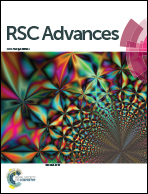Novel triazole derivatives as ecological corrosion inhibitors for mild steel in 1.0 M HCl: experimental & theoretical approach
Abstract
The present paper illustrates the investigation of two novel ecological triazole derivative corrosion inhibitors, namely ethyl 2-(4-phenyl-1H-1,2,3-triazol-1-yl) acetate [Tria-CO2Et], and 2-(4-phenyl-1H-1,2,3-triazol-1-yl) acetohydrazide [Tria-CONHNH2]. The studied inhibitors were investigated against the corrosion of mild steel in 1.0 M HCl solution using different electrochemical techniques. Potentiodynamic polarization experiments indicated that the [Tria-CO2Et], and the [Tria-CONHNH2] acted as mixed type inhibitors. Electrochemical impedance spectroscopy measurements revealed that both inhibitors presented a high inhibition performance, achieving an inhibition efficiency of 95.3% for [Tria-CO2Et] and 95.0% for [Tria-CONHNH2] at a concentration of 1.0 × 10−3 M. Based on the Langmuir isotherm model and the activation parameters, these triazole derivatives were adsorbed onto a steel surface by physical and chemical bonds. Density functional theory based on B3LYp6-311G(d,p) was also carried out to correlate the inhibition efficiencies obtained experimentally with the theoretical descriptors of the studied molecular structures.



 Please wait while we load your content...
Please wait while we load your content...